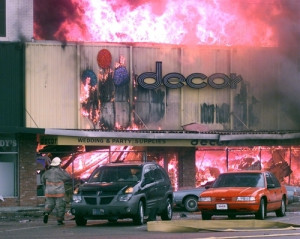At 10:45 a.m., a sudden release of natural gas burst from the ground under a store and a neighbouring shop in downtown Hutchinson, shattering dozens of store windows. Within minutes, the two businesses were ablaze; In the afternoon of the same day, 8 brine and natural-gas geysers began bubbling up, 2 to 3 miles east of the downtown fire, some reaching 30 ft (10 m) high, and two geysers ignited. The next day, natural gas coming up from such a long-forgotten brine well exploded under a mobile home, killing two people.
On January 17, 11 km northwest of the city, technicians from the natural-gas storage recorded a 0.7 MPa gas pressure drop in the S-1 salt cavern. It is believed that the pressure drop took place 15 min after the first downtown blast. The cavern had been refilled 3 days earlier. The well was plugged below the leaky level on January 24.
The underground storage had been developed in the 1980s to hold propane. Caverns had been leached out at a depth of 239 m below ground level. It seems that the field had frequent propane leaks. The owner became bankrupt, and the site was closed in the late 1980s. Wells were cased into the salt and later plugged by partially filling them with concrete. The site was acquired by a new company in the early 1990s and converted to a natural gas storage (at 4.2 Mpa). By 2001, 60 to 70 caverns were active, with a global storage volume of 108 Nm3.
The S-1 cavern belonged to a 16-cavern cluster (4 rows of 4 caverns), whose well heads were linked by a manifold. Pressures were recorded during normal operations through a unique pressure gauge, making leak detection improbable.
According to geological surveys carried out after the accident, leaking gas had moved vertically up the outside of the casing to a nearly horizontal gypsiferous/dolomitic zone up-dipping toward Hutchinson and then spread horizontally, the gas remaining trapped between two impermeable shale layers. The gas made its way over 8 years to the city, where it found abandoned brine wells (drilled in 1880 !), most of them only cased down to a shallow aquifer.
The S-1 cavern was probably leaky from the beginning (i.e., when the abandoned wells were redrilled for further use in 1993) and the leak had not been detected during the leak test performed before recommissioning of the cavern probably because at that time : the leak had probably not yet fully developed its pathway to above-laying layers and as no more saturated brine was available for the S1 cavern, the test was carried out with soft water which changed the testing gradient and thereby falsed the test.
New set of regulations were enforced, including mandatory double casing in wells, corrosion control, well conversion restrictions (salt caverns designed to store LPG could not be converted to store natural gas, and cavern wells that have been plugged cannot be reopened and used again), maximum pressure limit and new testing requirements (a leak test should be performed every 5 years).




